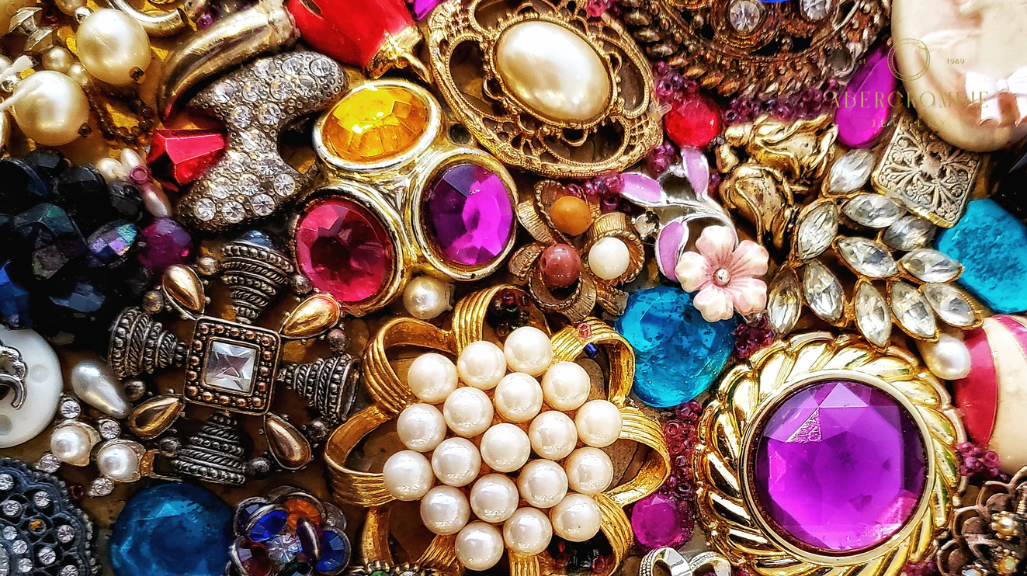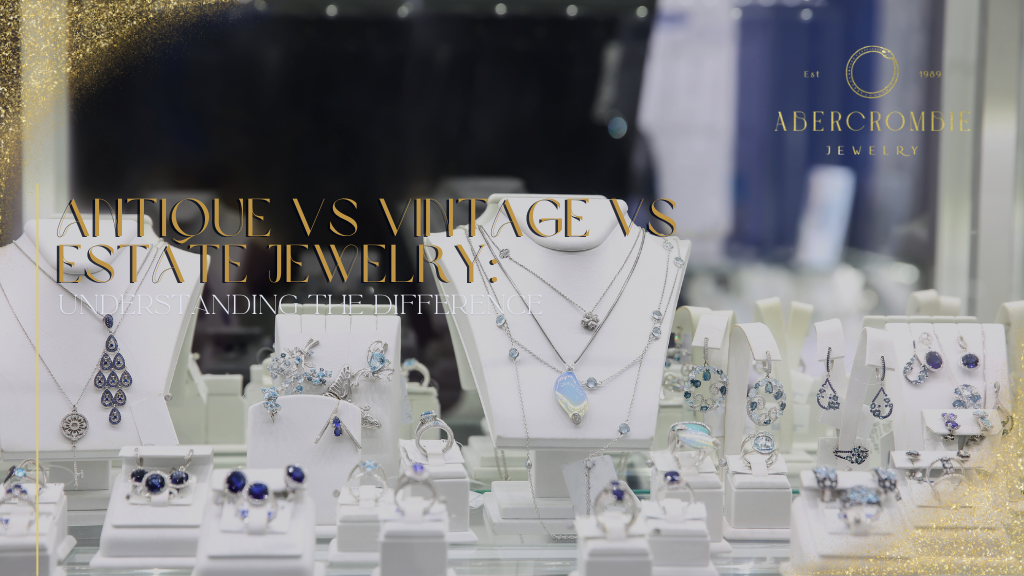Jewelry is not just a fashion statement; it’s a piece of history. Antique, vintage, and estate jewelry tell unique stories, reflecting different eras, craftsmanship, and cultural influences. Understanding the differences between these types of jewelry is crucial, especially for collectors, buyers, and enthusiasts who want to make informed decisions. Whether you’re seeking authenticity, value, or personal connection, knowing the difference between antique, vintage, and estate jewelry helps you appreciate each piece’s unique history and significance.
What is Antique Jewelry?

Antique jewelry refers to pieces that are over 100 years old. Antique engagement rings, for example, are second-hand jewelry from specific historical periods like the Georgian, Victorian, Edwardian, or Art Deco Eras, showcasing their historical significance and collectible value.
This category encompasses jewelry created during historical periods like the Victorian (1837-1901), Edwardian (1901-1915), Art Nouveau (1890-1910), and early Art Deco (1920-1935) eras. The Georgian era (1714-1837) is considered vintage and particularly significant for its handmade and rare pieces, contributing to their value in the antique market.
Antique jewelry is known for its intricate craftsmanship and use of high-quality materials like platinum, yellow gold, and silver. Many antique pieces feature old European-cut diamonds, pearls, sapphires, and emeralds set in elaborate designs. These pieces often include hand-engraved details, filigree work, and unique settings highlighting the jeweler’s artistry.
The Edwardian era is characterized by extravagant jewelry designs that often feature expensive materials like diamonds, rubies, and emeralds, showcasing the elegance and craftsmanship of the time. The Art Nouveau era revitalized the jeweler’s art, drawing inspiration from nature and incorporating advancements in techniques such as enameling and using new materials like opals and semi-precious stones.
Collectors are drawn to antique jewelry because of its rarity, historical significance, and exquisite craftsmanship. Each piece carries the essence of its era, offering a glimpse into traditions and cultures. Owning antique jewelry provides aesthetic pleasure and serves as a tangible piece of history that has stood the test of time. It’s like owning a miniature museum artifact, rich with stories and nostalgia.
What is Vintage Jewelry?
Vintage jewelry typically refers to pieces between 20 and 99 years old, encompassing styles from various eras: the Art Deco, Retro (1935-1950), and Mid-Century (1950-1965) periods. Vintage jewelry typically ranges from 50 to 100 years old, appealing to modern fashion enthusiasts for its unique blend of historical charm and contemporary style. While antique pieces reflect old-world craftsmanship, vintage jewelry marks a transition to more modern production techniques and design elements.
The Art Deco era (1920s-1930s) is characterized by geometric shapes, bold designs, and vibrant colored stones. The Retro era focused on bright, oversized gemstones, while the Mid-Century period introduced more playful designs, using synthetic stones and innovative materials like white gold. Vintage jewelry also includes pieces from the 1960s and 1970s, known for their bold, statement-making styles and use of mixed metals.
Vintage jewelry is popular among collectors due to its nostalgia, affordability, and unique designs that reflect the trends of their respective eras. It’s often more accessible than antique jewelry, making it an excellent option for those looking to own a piece of history without breaking the bank. Vintage jewelry also allows for more flexible styling and blends well with modern and traditional outfits.
How Vintage Differs from Antique Jewelry
While antique and vintage pieces reflect past eras, fundamental differences exist. An antique piece is entirely handcrafted, often showcasing unique design features specific to older periods and carrying more character and history. In contrast to modern pieces, vintage jewelry often combines traditional and emerging production techniques, resulting in classic and contemporary designs.
What is Estate Jewelry?
Estate jewelry refers to any pre-owned jewelry, regardless of age. Estate jewelry is categorized as such if it has a previous owner. This category includes both antique and vintage pieces, as well as more contemporary styles that have been previously owned. While estate jewelry doesn’t have a specific age requirement, it encompasses pieces with personal stories passed down through generations or sold as part of someone’s estate.
The condition of estate jewelry can vary widely, depending on how well it was cared for. Some pieces may be in near-perfect condition, while others may require professional cleaning or restoration to restore their original beauty.
Many people choose estate jewelry for its affordability and sustainability. Buying estate pieces offers a unique selection of styles and reduces the demand for newly mined gemstones and metals, making it an eco-friendly option. Additionally, vintage estate jewelry can offer access to rare designs and settings no longer produced, making it appealing for collectors and buyers seeking something unique. The jewelry industry uses specific terminology such as ‘vintage,’ ‘antique,’ and ‘estate’ to highlight the distinctions and historical significance of different eras and styles in current market offerings.
Understanding Jewelry Value and Authenticity

When it comes to antique, vintage, and estate jewelry, understanding a piece’s value, quality, and authenticity is crucial. Several factors can affect the value of a piece of jewelry, including its age, rarity, condition, and provenance.
Factors Affecting Value
- Age: The age of a piece of jewelry can significantly impact its value. Antique jewelry, for example, is typically more valuable than vintage jewelry due to its rarity and historical significance.
- Rarity: The rarity of a piece of jewelry can also impact its value. Limited edition or one-of-a-kind pieces can command higher prices due to their uniqueness.
- Condition: The condition of a piece of jewelry can also affect its value. Pieces in excellent condition, with minimal wear and tear, can command higher prices than those damaged or show significant signs of wear.
- Provenance: The provenance of a piece of jewelry, or its ownership history, can also impact its value. Pieces owned by famous or influential individuals can command higher prices due to their historical significance.
Identifying Authenticity
Identifying the authenticity of a piece of jewelry is crucial to determining its value. Here are some tips for identifying authenticity:
- Look for hallmarks or signatures: Many antique and vintage jewelry pieces are hallmarked or signed by the maker. Researching these hallmarks or signatures can help identify the piece’s authenticity.
- Examine the craftsmanship: Antique and vintage jewelry pieces are often handmade, with intricate details and craftsmanship. Examining the piece’s craftsmanship can help identify its authenticity.
- Research the style: Researching the style of the piece can help identify its authenticity. For example, Art Deco pieces are characterized by geometric shapes and bold designs, while Art Nouveau pieces are characterized by flowing, organic shapes.
The Importance of Accurate Terminology

Accurately describing antique, vintage, and estate jewelry is crucial to ensuring buyers and sellers are on the same page. Here are some key terms to keep in mind:
- Antique jewelry: Jewelry that is over 100 years old.
- Vintage jewelry: Jewelry that is between 20 and 100 years old.
- Estate jewelry: Jewelry that has been previously owned, regardless of its age.
- Art Deco: A jewelry style characterized by geometric shapes and bold designs, popularized during the 1920s and 1930s.
- Art Nouveau: A jewelry style characterized by flowing, organic shapes popularized during the late 19th and early 20th centuries.
Consulting with Experts
When buying or selling antique, vintage, or estate jewelry, consulting with experts in the field is essential. Here are some tips for finding and working with experts:
- Research local jewelers: Research local jewelers who specialize in antique, vintage, and estate jewelry.
- Look for certifications: Look for certifications from organizations such as the Gemological Institute of America (GIA) or the International Society of Appraisers (ISA).
- Ask for references: Ask for references from previous clients or colleagues.
- Get multiple appraisals: Get multiple appraisals from experts to accurately assess the piece’s value.
By understanding the value and authenticity of a piece of jewelry, using accurate terminology, and consulting with experts, buyers and sellers can ensure a smooth and successful transaction.
Key Differences Between Antique, Vintage, and Estate Jewelry

Understanding the distinctions and differences between antique, vintage, and estate jewelry helps buyers and collectors make informed decisions. Here’s a side-by-side comparison to clarify the key differences:
| Type | Age | Characteristics | Design Elements | Value |
|---|---|---|---|---|
| Antique | 100+ years | Rare, handcrafted, historical | Victorian, Edwardian, Art Nouveau | High value due to rarity and craftsmanship |
| Vintage | 20-99 years | Retro designs, mixed materials | Art Deco, Mid-Century, Retro | Affordable, trendy, nostalgic |
| Estate | Any age | Pre-owned, variable condition | Includes antique & vintage | Varies by piece and condition |
Antique, vintage, and estate are commonly used and sometimes misused in the jewelry world. Understanding these distinctions is crucial for informed purchasing and collecting of jewelry.
Knowing these differences can significantly impact purchasing decisions. Collectors who understand the nuances can better assess the authenticity and value of pieces, ensuring that their investments align with their personal tastes and historical interests.
Why These Differences Matter for Buyers and Collectors

Understanding the distinctions among antique, vintage antique, and estate jewelry is not just about terminology—it impacts investment potential, personal satisfaction, and authenticity.
- Practical Value: Knowing whether a piece is antique, vintage, or estate can influence its price and resale value. Due to their age and rarity, antique pieces often command higher prices, while vintage pieces offer a balance of uniqueness and affordability.
- Emotional Value: Each category holds its charm. Antique jewelry carries the weight of history, and vintage jewelry reflects recent past eras and estate jewelry offers personal stories from previous owners.
- Investment Potential: Antique and vintage jewelry, particularly rare or well-preserved pieces, can appreciate over time, making them valuable investments. Estate jewelry offers diverse options for those buying pre-owned pieces, often at more accessible prices.
The Arts and Crafts era (1894-1923) is a notable period in jewelry making that emphasized simple, handmade pieces as a reaction against the mass-produced styles of the Industrial Revolution. This era is characterized by visible craftsmanship and minimal decoration, highlighting techniques like hammered metals and handcrafted construction.
Understanding these differences allows buyers to appreciate each piece’s uniqueness, whether for personal use, as a gift, or as an investment.
Antique, vintage, and estate jewelry offer a unique glimpse into the past, showcasing different styles, materials, and stories. Whether you’re drawn to the intricate designs of antique pieces, the nostalgic appeal of vintage jewelry, or the affordability and variety of estate jewelry, understanding these differences helps you make informed purchase decisions as a buyer or collector.
Have antique, vintage, or estate jewelry you’d like to sell? Abercrombie Jewelry specializes in buying these unique pieces. Please schedule a consultation with our experts to evaluate your jewelry professionally and receive a competitive offer.

